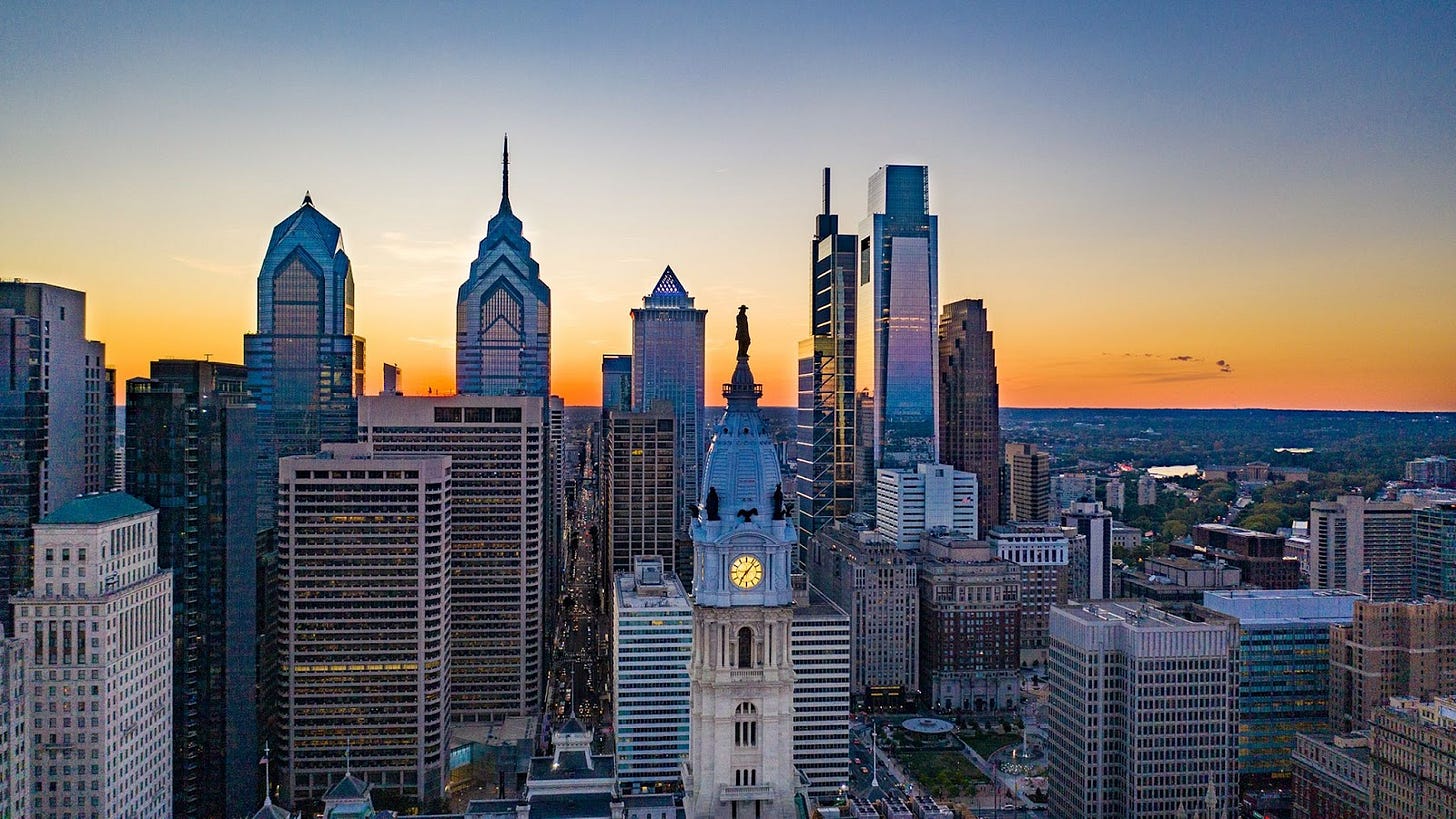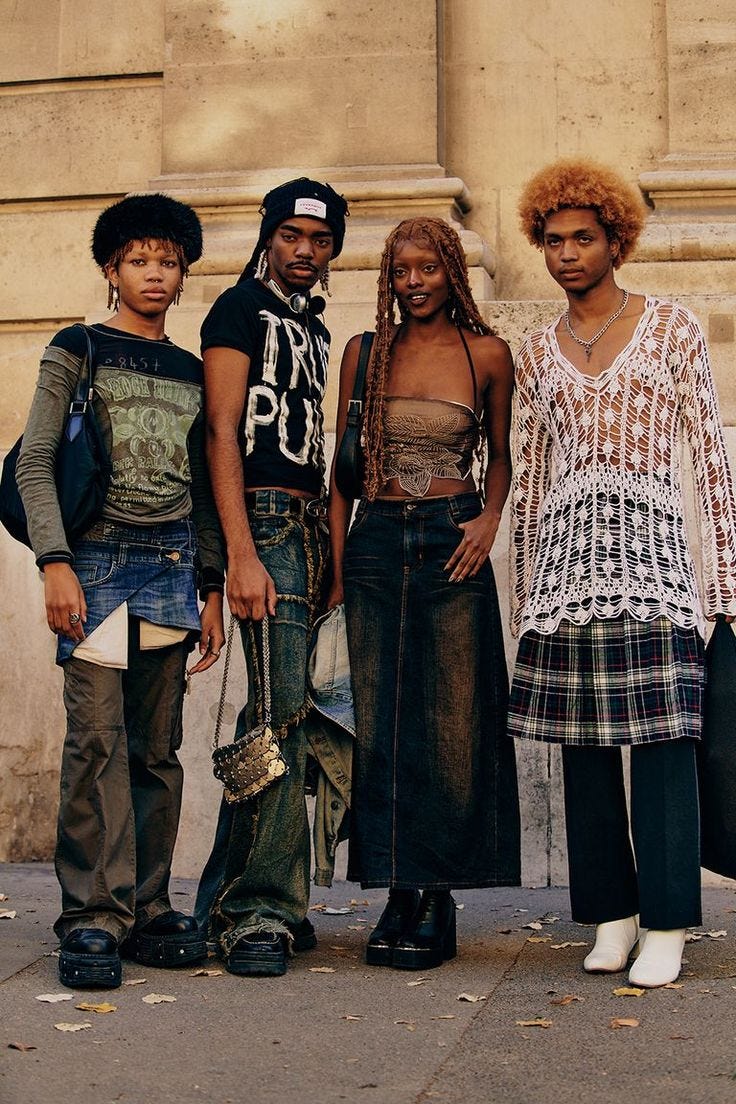Style Evolution: Liberation from the Pressures of Adolescence
Exploring how adolescent social norms, confidence, and education shape style and self-expression. Plus insights from Drexel University students.
Today, I’m thrilled to present to you a captivating piece by our talented guest writer, Simone. In her debut article for Fashion Talk, she explores the interplay between adolescent social norms, confidence, and education in shaping one’s personal style.
Through on-campus interviews with students at Drexel University, she unearths unique insights into students' experiences and perceptions. This on-the-ground research adds depth and authenticity to her exploration of the evolving landscape of style during the formative years.
Immerse yourself in Simone's insightful exploration, as she invites us to reflect on how societal influences shape our approach to fashion and, ultimately, how we liberate ourselves from the pressures of adolescence through our unique styles.
Happy reading,
Amarissa
The pressures of high school often lead individuals to experience a sense of stylistic confinement, with academic stress taking precedence and leaving little room for the consideration of personal expression within their daily routines.
The stressors students face, including coursework, social life, exams, adherence to social norms, dress codes, and more, can lead to reactions such as neglecting set chores, hobbies, or responsibilities, as noted by Fiona Yassin, the International Program Director at The Wave. These neglected tasks can include even the simplest of duties, such as picking out a stylish outfit.
In high school, I made a conscious effort to always showcase my self-expression and personal style. However, there were times when I couldn’t escape the pressures of adolescence and ended up wearing outfits that didn’t feel very me. My choice of clothing significantly affected how I navigated my day and how motivated I was to complete my coursework. If the fabric didn’t sit right, my energy would deplete and my mood would drop.
Since embarking on my journey at Drexel University, I’ve found a greater sense of comfort in expressing myself through my style. Even though college has many similar stressors to high school, the educational environment doesn’t stifle my personality under pressure. My style has experienced significant growth, and I now exude more confidence in my outfit choices. Even on lazy days, I find the motivation to accessorize and style my clothing, prioritizing comfort while maintaining a touch of personal flair. It feels as though I’ve broken the chains from the pressures of adolescence, enabling me to authentically express who I am. Intrigued by this evolution, I decided to explore whether my fellow Drexel students share similar sentiments.
Let’s Hear From the Students
In your high school years, did you experience any limitations or constraints when it came to expressing your personal style?
Samantha Mattei, a freshman majoring in Political Science, reveals that she experienced stylistic limitations at her high school because “it was in the suburbs, and there was not a lot of diversity. Everybody dressed pretty much like a carbon copy of each other, and if you wore jeans, it would get the same reaction as wearing a ball gown. [She remembers] getting dressed in the morning wanting to wear a cooler outfit or experimenting and [feeling], no, [she can’t] do that because of [her] environment.”
During questioning, Molly McKee, a first-year Product Design major, asserted, “Yes, I definitely felt like I couldn’t fully express myself through style in high school. Everyone I went to school with mainly wore Lulu Lemon or had a very [similar] sense of style, so I felt pressure to conform.”
Kylee Murphy, first-year Fashion Design major, was enrolled at a private high school and she felt “stylistically restrained because of all the crazy dress codes that [her] school implemented. For example, [she] couldn’t wear hoops bigger than a quarter or dye [her] hair, etc.”
When questioned about her experiences, Drew Malizia, a freshman majoring in Graphic Design, affirmed that she shared similar sentiments with the other students interviewed. In high school, she felt that there was a fear of judgment associated with wearing certain outfits.
Fashion Talk guest writer and Drexel Sophomore Joy Weinsoff attended boarding school and shared her perspective, stating, "I felt stylistically restrained in high school. This was likely the most crucial time for me to experiment with my style. There were occasions when I wanted to wear specific items, but my counselors would tell me they were inappropriate. I had to wear t-shirts and long sleeves even in 90 degrees out when I just wanted to wear a tank top."
What factors do you believe have prompted that evolution?
During my interview with Molly McKee, I inquired about the factors driving her style evolution since starting college. She responded, "I've felt more inclined to change my style in college because I'm surrounded by people who express themselves more freely through their fashion than anyone I encountered in high school. I also find myself more inclined to dress up in college compared to high school, mainly because I'm going out more throughout the day rather than simply walking down hallways from class to class."
Drew Malizia attributes her style evolution primarily to her social group, expressing greater comfort in the absence of a dress code at Drexel. She also notes a shift in concern about others' perceptions, emphasizing that in her hometown, where she knew everyone, such considerations were more prominent. At Drexel, she feels less preoccupied with external judgments.
When questioned whether Drexel University's location in Philadelphia has influenced her style evolution, Ingrid Burger responded, “In high school, being in the suburbs, there definitely was not as much experimental fashion around me, and it felt like more of a statement to experiment with my style… I still wanted to dress cool, and find my own style, but it was within certain constraints, whereas in the city, there is crazy fashion everywhere.”
As a fashion design major, Kylee Murphy is “exposed to other people [who are] also interested in fashion and seeing all of the diversity in styles has allowed [her] own style to evolve.”
Do you find it easier to express yourself through your style in college compared to high school?
Samantha Mattei points out why she feels more at ease in college, saying, "In high school, you've been with these people for so long, and you're in a bubble. It feels like if I make a bad impression of myself, then I'm kind of screwed. Whereas in college, I don't know any of these people. These people don't know me either, so it's a blank slate, and I like that. I think that makes it a more comfortable environment for people to be more expressive or more experimental."
Judgment was the primary obstacle to Ingrid Burger’s self-expression. However, she emphasizes that “[she is] definitely more comfortable expressing [her] style now than [she] was in high school. The people at Drexel [she feels] celebrates fashion more. When [she wears] an outfit that’s more out there, [she does] not feel people are looking at [her] and finding [her] outfit weird but rather people appreciate it just like [she] appreciate[s] everyone else’s style at Drexel”
In my conversation with Kylee Murphy, she highlighted the comfort she experiences expressing her style in college, particularly at Drexel. With a multitude of people, she noted, “No one really cares what you wear.” The environment is characterized by diverse styles, fostering a culture of fashion diversity.
Which social group do you hangout with, and does this have an impact on your style transformation?
Molly Mckee shares that she’s primarily surrounded by art and design majors, individuals that align their closets with their personal styles. While she began exploring her personal style in high school, the transition to college made her realize she had only scratched the surface. The presence of creative people in this environment, “really brought it out of [her].”
Samantha Mattei acknowledges that her friends play a role in influencing her style—not just based on their majors or clothing choices, but also in the reactions she receives when dressing cool or being more experimental. In high school, wearing certain outfits would elicit comments like "Oh my god, how do you have the energy to do that?" or "I can't believe you did that this morning, that's crazy." Now, she feels like she has almost been given permission to experiment because she’s surrounded by people who understand it and do the same thing.
As an art student, Ingrid Burger mentioned, "I primarily hang out with art students or honorary art students. I've definitely been influenced by these friends, and they've helped me evolve my style. For example, your style has inspired me to be more colorful, Molly and Kylee's styles have influenced me to wear more boots and invest in good jackets, Sam's style has motivated me to invest in off-the-shoulder tops, and Drew's style has made me invest in more winter accessories, etc. Seeing my friends always dressing up for classes inspires me more to dress up."
Having been at Drexel for two years, Joy Weinsoff engages with various social groups. One of these is the Jewish community, who dress more modestly, while her few friends from Israel embody a Mediterranean-inspired aesthetic. She acknowledges the influence of her friends on her style, particularly her close companion who consistently wears black. Joy recalls seeing certain pieces in her friends closets and thinking, “Oh, maybe this would look good on me.”
Drew Malizia mentions, “I’m not sure which specific group I hang out with, but everyone is very stylish. Back home not many of my friends dressed the same way I did, so having people around me expressing their style encouraged me to do the same.”
Interview Conclusions
Based on insights gathered from the students who generously participated in interviews, a discernible pattern emerges— the transition from high school to college frequently triggers an evolution in style. It’s disheartening, though unsurprising, to learn that all five students experienced a sense of stylistic restraint during their high school years. Whether imposed by a dress code, a fear of judgment, or a lack of diversity, each student encountered elements within their respective high schools that suppressed their self-expression. The common thread connecting these diverse experiences? Social norms.
Destroying Social Norms
Adolescence represents a particularly vulnerable phase in a person's life. During this time, the individuals surrounding you often establish the standard for what is deemed "normal" behavior, attire, attitude, or lifestyle. When you’re young, it’s easy to believe that the best way to live is by following the unspoken rules and guidelines set by others. At this stage, you’re a blank canvas, in the process of developing your own sense of style and self-expression.
Sophia Reis, reporting for The Temple News, reveals the vulnerability of young individuals succumbing to micro-trends in an effort to align with social norms. The promotion of short-term fashion trends by social media influencers makes it challenging for young consumers to resist purchasing popular products. While it's nearly impossible to disregard the fashion choices around you, rather than allowing this recognition to convince you that a particular look is "normal," it should be viewed as an appreciation of personal style.
Observing how others choose to dress should not become a source of envy or self-criticism. Acceptance from peers doesn’t require conforming to the clothing choices of others. The key is to listen to your inner identity and authentically express yourself. Wearing an outfit that aligns with your genuine self and makes you feel confident will always be stylish.
Confidence is Essential
Being confined in an isolated environment can limit someone from expanding their style. This constraint makes it challenging to maintain an ever-evolving fashion sense and wear what makes you happy. Wearing clothing that makes you unhappy can diminish confidence, and confidence is crucial for self-expression. While having a unique style might lead to feeling ostracized, it's essential to appear confident. Individuals who are mean or judgmental are often projecting their own insecurities onto others, and they may feel threatened if their words don't make an impact.
While social media often reinforces social norms and showcases the latest micro-trends, its expansive network can also reveal the existence of countless others who support diverse forms of self-expression. In the current digital landscape, uniqueness is celebrated online and on social media platforms. Rather than conforming to specific styles, having a distinct look is considered "cool." Alternative content creators openly share their style evolution, offering adolescents a reassuring outlet where they can express themselves without fear of judgment.
Style Icons
While it may be unhealthy to believe that copying influencers is necessary for acceptance, having a fashion icon is undoubtedly valuable. Numerous inspirations, such as Prince, Tyler, The Creator, Vivienne Westwood, Rihanna, and Myra Magdalen, influence my personal style. If the fashion choices of your favorite content creator make you feel stunning, embrace it! Content creators thrive on influencing their supporters, and there's creativity in preserving your unique style while incorporating pieces from someone else’s.

All the students I spoke with drew fashion inspiration from those around them or social media personalities. Ingrid Burger, influenced by TikTokers @benulus or Berenice Castro, finds motivation to accessorize more. Samantha Mattei looks up to singer Lana Del Rey for her Old Hollywood style. Molly Mckee admires the classy and rugged designs of Ralph Lauren’s American Heritage. Kylee Murphy draws inspiration from Alexa Chung, Alexandra Yvette, and Kate Bartlett. Joy Weinsoff is influenced by European and Scandinavian styles, particularly by designer Matilda Djerf. These diverse inspirations allow Drexel students to experiment with their own style, learning new ways without compromising their unique self-expression.

Style Evolution
Continually evolve your style by disregarding societal norms and listening to your inner voice of self-expression. The college students I spoke with feel more comfortable and less restrained compared to high school, crediting the fewer social norms. Alum Alexa from Northwestern University notes, "there is no definition of 'normal' in college, no standard for you to adhere to. College is made up of so many students from different backgrounds and with different interests that it's impossible to try to define what is normal" (Admitsee.com).
This holds especially true in environments that encourage self-expression and bolster confidence. Unlike the monotony of navigating the same building daily, college propels students to move and explore. Enrolling at Drexel University and other urban colleges teaches you that everyone is too immersed in their own lives to concern themselves with what you're wearing. So long as your outfits ignite excitement within you, you'll possess the confidence to liberate yourself from social norms and unapologetically be yourself.
Final oversight & edits by Amarissa.
Today’s writer…
Simone is a participant in Fashion Talk's Winter ‘24 Student Writing Program. Aligned with our mission to uplift young voices in the fashion industry, we’re excited to share her fresh and insightful perspective with our community.
Get to know Simone here.
connect with us: IG → pinterest → twitter → bluesky












